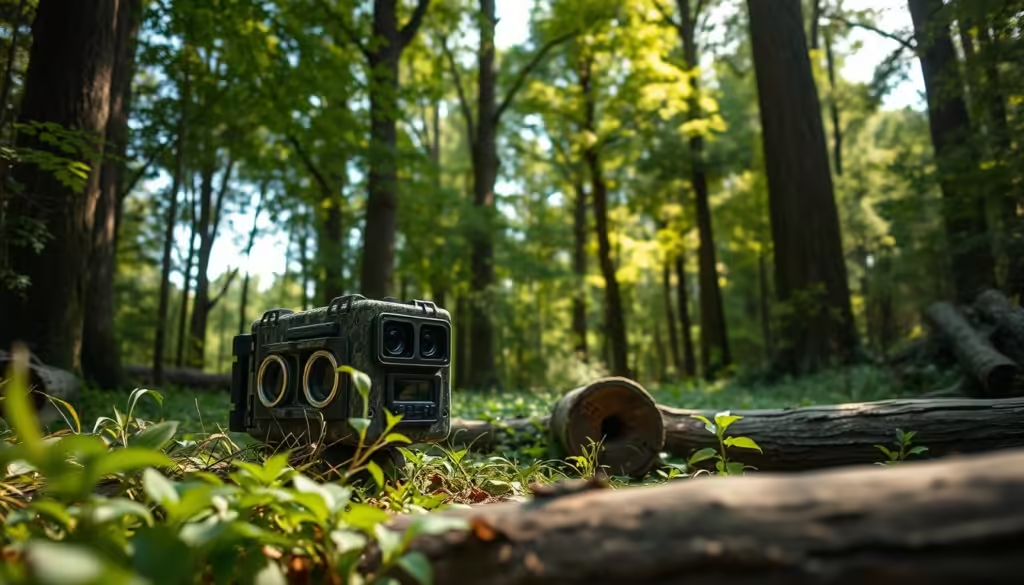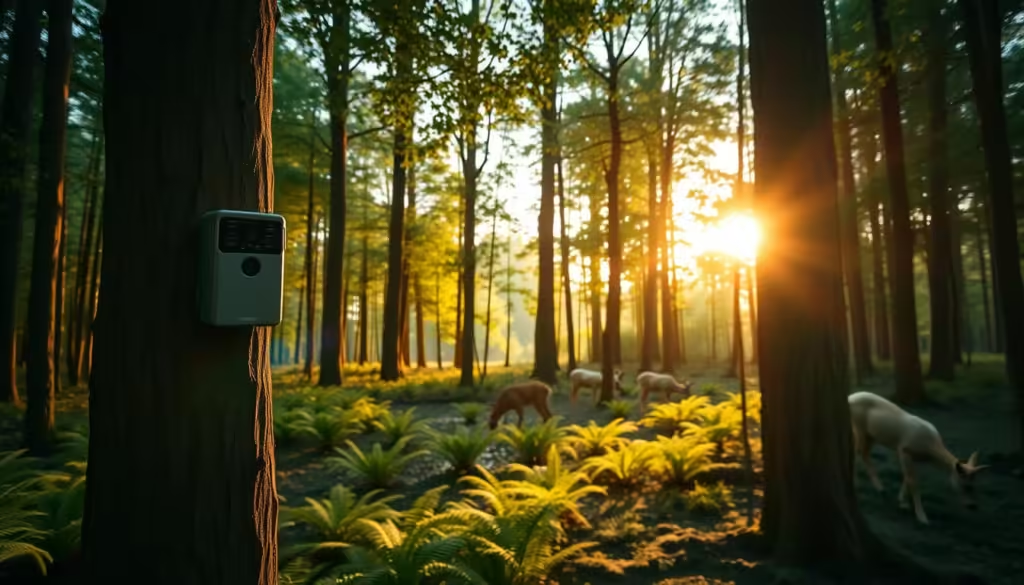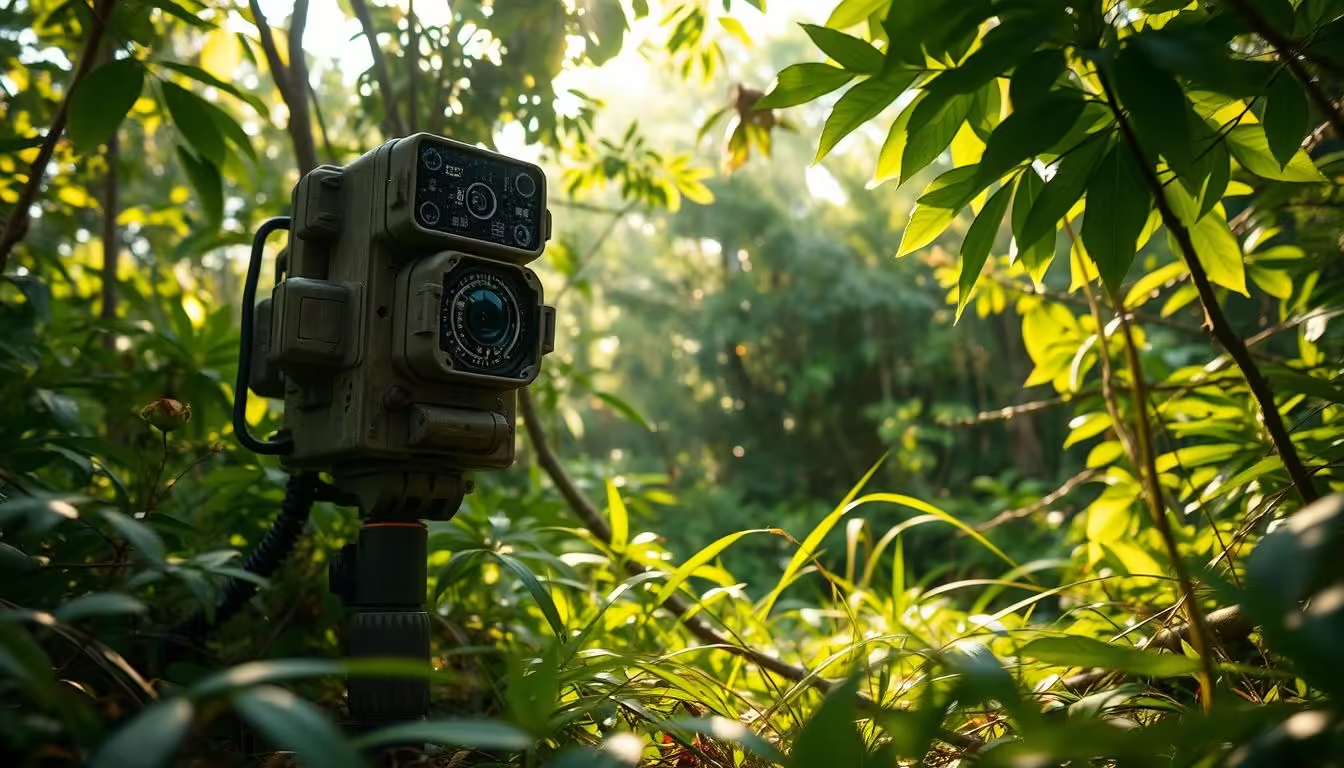Wildlife conservation has taken a significant leap forward with the introduction of AI-powered camera traps. These innovative devices are revolutionizing the way we monitor and protect endangered species in their natural habitats.
Unlike traditional camera traps, AI-powered ones can distinguish between different species, reducing the need for human intervention and minimizing the disturbance to the animals. This non-invasive approach not only aids in the accurate tracking of wildlife but also plays a crucial role in preventing poaching activities.
By leveraging AI technology, conservationists can now gather detailed insights into the behavior, population dynamics, and habitat usage of various species, thereby informing more effective conservation strategies.
Key Takeaways
- AI-powered camera traps enhance wildlife conservation efforts.
- They minimize disturbance to animals while tracking species.
- These camera traps are effective in preventing poaching.
- AI technology aids in gathering detailed insights into species behavior.
- Conservation strategies become more informed and effective.
The Evolution of Wildlife Monitoring Technology
The wildlife monitoring technology landscape has undergone significant transformations over the years, revolutionizing the way conservation efforts are carried out. This evolution has been crucial in enhancing our ability to track and protect endangered species effectively.
From Manual Tracking to Digital Surveillance
Traditionally, wildlife monitoring involved manual tracking methods, which were often time-consuming and labor-intensive. The advent of digital surveillance marked a significant shift, enabling more efficient and accurate monitoring of wildlife populations.
The Emergence of Camera Traps in Conservation

Early Motion-Triggered Systems
Early camera trap systems were motion-triggered, capturing images when animals moved into their field of view. This technology significantly reduced the need for human presence in sensitive habitats.
Integration of Artificial Intelligence
The integration of artificial intelligence (AI) into camera traps has further enhanced their effectiveness. AI algorithms can now process images to identify species, reducing manual analysis time and increasing the accuracy of wildlife monitoring data.
Understanding AI-Powered Camera Traps
Camera traps equipped with AI are changing the way we monitor and protect endangered species. These advanced devices combine hardware and software to capture and analyze images of wildlife, providing valuable insights into their behavior and habitats.
Components and Technical Specifications
The effectiveness of AI-powered camera traps depends on their components and technical specifications. Key elements include:
- High-resolution cameras for clear image capture
- Infrared or night vision capabilities for monitoring at night
- Weather-resistant housing for durability in various environments
Hardware Elements and Durability Features
The hardware of these camera traps is designed to withstand harsh environmental conditions. Features include:
- Robust construction to resist damage from wildlife or weather
- Sealed units to protect against moisture and dust
Power Solutions for Remote Deployment
To enable remote deployment, AI-powered camera traps often utilize:
- Battery power with long lifespan or solar charging capabilities
- Energy-efficient designs to minimize power consumption

How AI Algorithms Process Wildlife Images
AI algorithms play a crucial role in analyzing the images captured by these camera traps. They enable:
Species Recognition Capabilities
The AI can identify specific species, reducing manual effort and increasing accuracy. This capability is essential for:
- Monitoring population sizes
- Tracking species distribution
Behavioral Pattern Analysis
Beyond species recognition, AI algorithms can analyze behavioral patterns, such as:
- Activity patterns (e.g., diurnal or nocturnal behavior)
- Social interactions among wildlife
By understanding these behaviors, conservationists can develop more effective protection strategies.
The Non-Invasive Advantage: Monitoring Without Disturbance
AI-powered camera traps are revolutionizing wildlife monitoring by providing a non-invasive means of tracking animals in their natural habitats. This approach has been hailed as a significant advancement in conservation efforts, allowing researchers to gather crucial data without disrupting the natural behaviors of the animals being studied.
Minimizing Human Presence in Sensitive Habitats
One of the primary benefits of using AI-powered camera traps is the ability to minimize human presence in sensitive habitats. By reducing the need for physical presence, these camera traps help preserve the natural state of the environment, allowing for more accurate observations of wildlife behaviors.
Reducing Stress on Wildlife Populations
Traditional monitoring methods can often cause significant stress to wildlife populations, potentially altering their natural behaviors. AI-powered camera traps mitigate this issue by providing a non-invasive means of monitoring, thereby reducing the stress on the animals and ensuring that the data collected is more representative of their natural behaviors.

Capturing Natural Behaviors and Interactions
By minimizing human disturbance, AI-powered camera traps enable researchers to capture more natural behaviors and interactions within wildlife populations. This not only enhances our understanding of these animals but also informs more effective conservation strategies.
As noted by a conservation expert, “The use of AI-powered camera traps has been a game-changer for our conservation efforts, allowing us to monitor wildlife in a way that is both effective and non-invasive.”
“The use of camera traps has revolutionized the way we monitor wildlife, providing insights that were previously unimaginable.”
Tracking Endangered Species with Precision
AI-powered camera traps are revolutionizing the way we track endangered species, offering unprecedented precision in conservation efforts. By leveraging advanced AI algorithms, these camera traps can identify species, monitor populations, and study behaviors with minimal human intervention.
Species Identification Through AI Pattern Recognition
The AI technology integrated into camera traps enables the identification of individual animals and species through pattern recognition. This capability is crucial for accurate population counting and monitoring.
Individual Animal Identification
AI algorithms can distinguish between individual animals based on unique characteristics, such as coat patterns or scars. This allows for more precise tracking and monitoring of specific animals within a population.
Population Counting Accuracy
By accurately identifying and counting individuals, conservationists can obtain a more reliable understanding of population sizes. This information is vital for developing effective conservation strategies.
Population Monitoring and Behavioral Studies
Beyond species identification, AI-powered camera traps facilitate comprehensive population monitoring and behavioral studies. This includes observing migration patterns, habitat use, and breeding behaviors.
Migration Patterns and Habitat Use
Camera traps can capture data on the migratory routes and habitat preferences of endangered species. Understanding these patterns helps conservationists protect critical habitats and migration corridors.
Breeding Behaviors and Success Rates
Observing breeding behaviors and success rates provides insights into the reproductive health of endangered species. This information is crucial for assessing the effectiveness of conservation efforts.
| Species | Migration Patterns | Breeding Success Rates |
|---|---|---|
| Amur Leopard | Seasonal migration between Russia and China | Low due to habitat fragmentation |
| Mountain Gorilla | Limited migration within protected areas | Moderate, with efforts to enhance habitat |
| Sumatran Tiger | Minimal migration due to isolated habitats | Low, impacted by poaching and habitat loss |
The data collected through AI-powered camera traps is invaluable for conservation efforts. By analyzing migration patterns, breeding behaviors, and population dynamics, conservationists can develop targeted strategies to protect endangered species.
Anti-Poaching Applications and Success Stories
In the fight against wildlife poaching, AI-powered camera traps have emerged as a crucial tool, offering advanced surveillance capabilities. These innovative systems are not only detecting poaching activities but also preventing them through swift action and strategic deterrence.
Real-Time Alerts and Response Systems
One of the most significant advantages of AI-powered camera traps is their ability to send real-time alerts to conservationists and authorities when they detect suspicious activity. This immediate notification system enables rapid response teams to intervene before poaching attempts are successful.
For instance, in South Africa’s Kruger National Park, AI camera traps have been instrumental in detecting and deterring poachers. The system sends alerts to park rangers, who can then quickly respond to potential threats.
Deterrence Through Surveillance Networks
The visible presence of AI-powered camera traps acts as a deterrent to potential poachers. Knowing that their actions could be monitored and reported, poachers are less likely to operate in areas covered by these advanced surveillance networks.
“The use of AI in camera traps has been a game-changer for us. It’s not just about detecting poachers; it’s about creating a secure environment for our wildlife to thrive.” – Conservation Expert
Notable Poaching Prevention Cases
Several success stories highlight the effectiveness of AI camera traps in preventing poaching:
Rhino Protection in South Africa
In South Africa, AI camera traps have been deployed to protect rhino populations. The results have been promising, with a significant reduction in poaching incidents.
Elephant Safeguarding in Kenya
Kenya has also seen positive outcomes from using AI-powered camera traps to safeguard its elephant populations. The technology has helped conservationists monitor and protect these majestic creatures more effectively.
| Location | Species Protected | Poaching Reduction |
|---|---|---|
| South Africa | Rhinos | 40% |
| Kenya | Elephants | 30% |

The integration of AI technology with traditional conservation methods is proving to be a powerful strategy in the fight against wildlife poaching. As these technologies continue to evolve, we can expect even more effective anti-poaching applications in the future.
Earth, Technology, Climate Change and Environmental Sustainability Through Green Tech
The integration of green technology in wildlife conservation is revolutionizing our approach to environmental sustainability. As we continue to grapple with the challenges of climate change, the role of green tech in conservation efforts becomes increasingly vital.
Reducing Carbon Footprint in Conservation Efforts
One of the significant advantages of green tech in wildlife conservation is its potential to reduce the carbon footprint associated with conservation efforts. Traditional conservation methods often rely on fossil fuels for power, contributing to greenhouse gas emissions. In contrast, green tech offers innovative solutions to minimize this impact.
Solar-Powered and Energy-Efficient Designs
Solar-powered camera traps are a prime example of green tech in action. These devices can operate for extended periods without the need for battery replacements or fossil fuel-powered generators, significantly reducing their carbon footprint. Energy-efficient designs further enhance the sustainability of these technologies.
| Technology | Carbon Footprint Reduction | Energy Efficiency |
|---|---|---|
| Solar-Powered Camera Traps | High | Excellent |
| Energy-Efficient Sensors | Moderate | Good |
| Wind-Powered Monitoring Systems | High | Excellent |
Monitoring Climate Change Effects on Wildlife
Green tech also enables conservationists to monitor the effects of climate change on wildlife more effectively. By leveraging advanced technologies such as AI-powered camera traps and satellite imaging, researchers can gather critical data on how climate change is impacting various species and ecosystems.

By embracing green tech, we can enhance environmental sustainability, reduce our carbon footprint, and protect wildlife from the adverse effects of climate change.
Case Studies: AI Camera Traps in Action
The deployment of AI-powered camera traps has marked a significant milestone in the protection of endangered species. These innovative tools have been instrumental in various conservation efforts worldwide, providing valuable insights into wildlife behavior and population dynamics.
Elephant Monitoring in African National Parks
In African national parks, AI camera traps have been used to monitor elephant populations effectively. This has enabled conservationists to track population recovery and understand the dynamics of human-wildlife conflict.
Population Recovery Tracking
By analyzing data from AI camera traps, researchers have been able to monitor the recovery of elephant populations in protected areas. This information is crucial for adjusting conservation strategies to ensure the long-term survival of these majestic creatures.
Human-Wildlife Conflict Reduction
AI camera traps have also helped in reducing human-wildlife conflict by identifying areas where elephants and humans interact closely. This allows for targeted interventions to prevent conflicts and protect both humans and elephants.
Tiger Conservation in Southeast Asia
In Southeast Asia, AI camera traps have been pivotal in tiger conservation efforts. By monitoring tiger populations and their habitats, conservationists can implement more effective protection measures.
Rare Species Documentation in the Amazon
The Amazon rainforest, home to a vast array of biodiversity, has benefited from the deployment of AI camera traps. These devices have enabled researchers to document rare species and observe previously undocumented behaviors.
Discovery of Previously Undocumented Behaviors
The use of AI camera traps in the Amazon has led to the discovery of new behaviors among rare species. This has significantly expanded our understanding of these species and their ecological roles, informing more effective conservation strategies.
The success of AI camera traps in these case studies underscores their potential as a powerful tool in wildlife conservation. By continuing to deploy and improve this technology, we can make significant strides in protecting endangered species and preserving ecosystems.
Data Management and Analysis in Conservation Efforts
As conservation efforts become more data-driven, the importance of efficient data management and analysis cannot be overstated. The vast amounts of data collected from AI-powered camera traps and other sources require robust systems to store, process, and analyze them effectively.
Cloud-Based Storage Solutions
Cloud-based storage has revolutionized the way conservation data is managed. It offers scalable, secure, and accessible storage options that can be accessed from anywhere in the world. This is particularly beneficial for global conservation initiatives that involve multiple stakeholders and locations.
Machine Learning for Predictive Conservation
Machine learning algorithms can be applied to large datasets to identify patterns and predict future trends. In conservation, this can help in identifying areas at high risk of poaching or predicting the impact of environmental changes on wildlife populations.
Sharing Data Across Global Research Networks
Collaboration and data sharing are crucial in conservation efforts. By sharing data across global research networks, conservationists can gain a more comprehensive understanding of global trends and challenges, ultimately leading to more effective conservation strategies.
| Data Management Approach | Benefits | Applications in Conservation |
|---|---|---|
| Cloud-Based Storage | Scalable, secure, accessible | Global data sharing, remote access |
| Machine Learning | Pattern identification, predictive analytics | Poaching prediction, habitat monitoring |
| Data Sharing Networks | Collaboration, comprehensive insights | Global trend analysis, strategy development |
Challenges and Limitations of AI Camera Trap Technology
Despite the advancements in AI camera trap technology, several challenges hinder its effectiveness in wildlife conservation. The deployment of these systems in remote areas is fraught with difficulties that impact their overall performance and reliability.
Technical Constraints in Remote Environments
The harsh conditions in wilderness areas pose significant technical challenges to AI camera traps. These include:
- Extreme weather conditions that can damage equipment
- Difficulty in maintaining connectivity in areas with poor network coverage
Weather and Climate Challenges
AI camera traps are often exposed to extreme weather conditions such as heavy rainfall, intense heat, or freezing temperatures. These conditions can affect the durability and functioning of the equipment. For instance, a study on camera traps in the Amazon rainforest highlighted that extreme weather was a major cause of equipment failure.
Connectivity Issues in Wilderness Areas
Another significant challenge is maintaining connectivity in remote areas. Many AI camera traps rely on cellular or satellite networks to transmit data. However, in areas with poor network coverage, this can be a significant issue. As noted by a conservationist, “The lack of reliable connectivity hinders the real-time monitoring capabilities of camera traps.”
| Challenge | Impact | Potential Solution |
|---|---|---|
| Weather Conditions | Equipment Damage | Weatherproof Housing |
| Connectivity Issues | Data Transmission Delays | Satellite Connectivity |
Accuracy Issues and False Positives
AI algorithms used in camera traps can sometimes misidentify species or trigger false alarms. This can lead to unnecessary resource expenditure on false positives. According to a recent study, “Improving the accuracy of AI algorithms is crucial for the effective use of camera traps in conservation.”
“The key to successful conservation lies in the ability to accurately monitor and understand wildlife populations. AI camera traps have the potential to revolutionize this field, but addressing their limitations is crucial.”
Funding and Accessibility Barriers
The cost of AI camera trap technology and the expertise required to maintain it can be a barrier for many conservation organizations, especially in developing countries. As a result, there is a need for more accessible and affordable solutions.
Addressing these challenges is essential for the widespread adoption and effectiveness of AI camera trap technology in wildlife conservation. By understanding and mitigating these limitations, we can enhance the role of AI camera traps in protecting endangered species and preserving biodiversity.
Collaborative Conservation: Partnerships Driving Innovation
The power of partnerships is being harnessed to drive innovation in conservation. By bringing together diverse stakeholders, collaborative conservation efforts are yielding significant results in protecting endangered species and preserving ecosystems.
Technology Companies and Conservation Organizations
Technology companies are playing a crucial role in conservation by providing innovative solutions and resources. For instance, AI-powered camera traps developed in collaboration with conservation organizations are helping to monitor wildlife populations more effectively.
- Microsoft’s AI for Earth initiative is supporting conservation efforts through technology.
- Google’s collaboration with conservation organizations is enhancing species identification.
- Amazon’s AWS is providing cloud storage solutions for conservation data.
Government Initiatives and International Cooperation
Governments and international organizations are also crucial in driving conservation efforts. Initiatives such as the Convention on International Trade in Endangered Species of Wild Fauna and Flora (CITES) are promoting global cooperation to protect endangered species.
Community Involvement and Indigenous Knowledge Integration
Community involvement is vital for the success of conservation initiatives. Integrating indigenous knowledge into conservation strategies is enhancing their effectiveness and ensuring that local communities are engaged in protecting their natural heritage.
- Community-led conservation projects are being implemented in various regions.
- Indigenous knowledge is being used to develop more effective conservation strategies.
The Future of AI in Wildlife Monitoring
Emerging technologies are set to enhance the capabilities of AI-powered camera traps in wildlife conservation. The future of AI in wildlife monitoring holds much promise, with potential advancements in data analysis, species identification, and habitat monitoring.
Emerging Technologies and Integration Possibilities
The integration of new technologies with existing AI-powered camera traps is expected to significantly boost their effectiveness. One such development is the coordination between drone technology and camera traps.
Drone and Camera Trap Coordination
Drones can be used to deploy camera traps in hard-to-reach areas or to survey large territories quickly. This coordination can provide a more comprehensive view of wildlife populations and their habitats.
Advanced Biometric Recognition Systems
Biometric recognition systems, such as those using animal facial recognition or behavioral patterns, can further enhance the accuracy of species identification and monitoring.
Expanding Applications Beyond Endangered Species
While AI-powered camera traps have been primarily used for monitoring endangered species, their application can be expanded to study other wildlife populations. This can provide valuable insights into ecosystem health and biodiversity.
Potential for Ecosystem-Wide Monitoring
The future of AI in wildlife monitoring also includes the potential for ecosystem-wide monitoring. By integrating data from various sources, including camera traps, drones, and sensor networks, researchers can gain a more holistic understanding of ecosystems and the impact of environmental changes.
Conclusion: Balancing Technology and Nature in Wildlife Protection
As we reflect on the role of AI-powered camera traps in wildlife conservation, it becomes clear that these innovative tools are revolutionizing the way we protect endangered species. By leveraging AI algorithms and camera trap technology, conservationists can monitor wildlife populations without disturbing their natural habitats.
The key to successful wildlife protection lies in balancing technology with nature. AI-powered camera traps offer a non-invasive means of tracking and monitoring wildlife, providing valuable insights into their behavior, population dynamics, and habitat needs. This information is crucial for developing effective conservation strategies that safeguard the future of vulnerable species.
As we move forward, it is essential to continue refining AI-powered camera trap technology, addressing the challenges and limitations associated with its use. By doing so, we can ensure that these tools remain a vital component of our conservation efforts, helping to protect wildlife and preserve the natural world for generations to come.
FAQ
What is the primary purpose of using AI-powered camera traps in wildlife conservation?
The primary purpose is to track endangered species and prevent poaching without disturbing the animals, utilizing AI for efficient monitoring and data analysis.
How do AI-powered camera traps differ from traditional camera traps?
AI-powered camera traps integrate artificial intelligence algorithms to process wildlife images, enabling species recognition, behavioral pattern analysis, and more accurate data collection compared to traditional camera traps.
What are the benefits of using solar-powered camera traps in conservation efforts?
Solar-powered camera traps reduce the carbon footprint associated with conservation efforts, providing a sustainable and energy-efficient solution for remote deployments.
Can AI camera traps be used for monitoring beyond endangered species?
Yes, AI camera traps have the potential for ecosystem-wide monitoring, allowing for the observation of various species and their interactions within an ecosystem.
What are some challenges associated with deploying AI camera traps in remote environments?
Challenges include technical constraints such as weather and climate challenges, connectivity issues in wilderness areas, and the potential for accuracy issues and false positives.
How do conservation organizations and technology companies collaborate in the development of AI-powered camera traps?
Collaboration involves partnerships between technology companies and conservation organizations to drive innovation, improve technology, and enhance conservation efforts through the effective use of AI camera traps.
What role does data management play in the effectiveness of AI camera trap deployments?
Data management, including cloud-based storage solutions and machine learning for predictive conservation, is crucial for analyzing the large datasets generated by AI camera traps, enabling informed conservation decisions.
Are there any notable examples of AI camera traps being used successfully in conservation projects?
Yes, examples include elephant monitoring in African national parks, tiger conservation in Southeast Asia, and rare species documentation in the Amazon, showcasing the effectiveness of AI camera traps in various conservation contexts.

